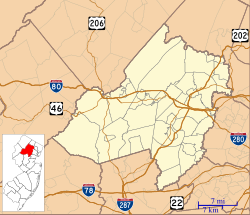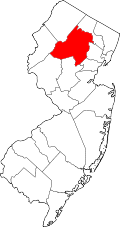Chatham Township was incorporated by an act of the New Jersey Legislature on February 12, 1806, from portions of Hanover Township and Morris Township. [26] [27] At the time Chatham Township was created, it included the communities of Chatham, Green Village and Bottle Hill (Madison), together with the extensive rural areas surrounding these communities, with each community retaining its own distinct existence and identity. Before the close of that century however, the township would lose all except one of the settlements under its jurisdiction, as they seceded from the township and established their own municipal governments.
The community known as Bottle Hill was established in the early eighteenth century in Morris Township when the area was within the English Province of New Jersey. Bottle Hill changed its name to Madison in 1834 to honor President James Madison. [28] On December 27, 1889, Madison was incorporated as an independent borough and its former village boundaries were expanded between 1891 - 1899 with annexed portions of rural lands that had formerly been within the township. [26]
The settlement of Chatham had been established in 1710 as John Day's Bridge and, in 1773 when New Jersey was an English province, adopted the name of Chatham to honor William Pitt, 1st Earl of Chatham, a British supporter of the colonial cause. [29] [30] [31] This village also had been within Morris Township and it was an active community in the Revolutionary War. On August 19, 1892, Chatham seceded from the new township that had taken its name and adopted the village form of government established in the United States for the new state of New Jersey. Shortly thereafter, Chatham adopted the borough form of government on March 1, 1897. [26]
Florham Park was formed from portions of the township on March 20, 1899. [26] [32]
Most of Green Village has always been within the township's jurisdiction.
In 1773, the village John Day's Bridge, a community governed by the English township of Morris since its settlement in 1710, was renamed as, Chatham, in honor of Sir William Pitt, a British prime minister and the first Earl of Chatham, who was most favorable toward the colonists of the Province of New Jersey in issues with the British government. [29] Participation in the Revolutionary War was significant by the residents of Chatham. Nearby Morristown was the military center of the revolution, where the winter headquarters were established twice, and revolutionary troops were active in the entire area regularly.
The township form of government is the oldest form of municipal government in the state of New Jersey following the revolution. That form of local government dates back to New Jersey's Township Act of 1798. Chatham Township was formed on February 12, 1806, with jurisdiction over the area of present-day Chatham Borough several communities and settlements, including some that had been part of Hanover and Morris Townships. [26] A great deal of open, swampy, and mountainous land was included with the hamlets.
For a while, the new township included what are now Madison, Chatham Borough and Florham Park, as well as all of Green Village and all of the lands still governed by Chatham Township, but over time these settlements began to secede because of contention over insufficient funding of their projects. Disposition of funds from taxes was perceived as inequitable to the settled areas given their needs versus that of the rural areas, causing them to form their own taxation and governance systems. [33]
Of the pre-revolutionary settlements included in its jurisdiction when it was formed, only portions of Green Village have remained governed by Chatham Township, which has never had a community center.
On December 27, 1889, based on the results of a referendum passed three days earlier, the village of Madison seceded from Chatham Township and adopted the borough form of government in order to develop a local water supply system for its population of 3,250. Madison annexed additional portions of Chatham Township in 1891, and annexed more each year from 1894 to 1898, followed finally, by an exchange of some lands in 1899 with Chatham Township. [26]
In the midst of these changes, in 1892 "...Chatham Village found itself at odds with the rest of the township. Although village residents paid 40 percent of the township taxes, they got only 7 percent of the receipts in services. The village had to raise its own money to install kerosene street lamps and its roads were in poor repair. As a result, the village voted on August 9, 1892, to secede from the township." [29]
The municipality that is now Florham Park was originally part of Hanover Township, before being included in the township formed in 1806 as Chatham Township. When it seceded from Chatham Township, it incorporated as a borough as Florham Park on March 20, 1899. [26] [32]
The boundaries of Chatham Township have remained unchanged since 1899.
Post-World War II suburban development ensued in the 1950s when farm lands, greenhouses, and flower nurseries began to be sold off. [33] Families moved out to this rural suburban area as ownership of automobiles increased dramatically.
The township experienced even more extensive residential development, starting with the 1960s and 1970s, when rezoning enabled residential development of the open spaces and several farms and woodlands were sold off to developers. [34] For several generations, the largest, the Schwartz Farm had produced dairy products that were sold in local stores and schools and that were delivered to homes on scheduled routes. Former rose farms became two major shopping centers near the corner of Shunpike Road and Southern Boulevard. The corner was known as Hickory Tree, named for a hickory tree planted during President Madison's term. [33] [34]
Heyl Roses in Green Village was the last and oldest commercial rose and cut flower grower in New Jersey, until its closure in 1999. [35]
After successfully crossing the Delaware River and subsequent battles in Trenton and Princeton, General Washington marched to Morristown and established his headquarters in Arnold's Tavern on the Morristown Green for the Continental Army’s first winter encampment. Most of the army was sent a few miles southeast to the Lowantica Valley (modern spelling Loantaka) in Chatham Township, at a site located north of Loantaka Brook, East of Tredwell Avenue and West of Giralda Farms. In 2016, the Morris County Park Commission and the Chatham Township Historical Society began working together to reclaim the area and create trails and apply for grants for informational signage. [36] [37]















